Finals look different after first full semester of distance learning

Capping off the first full semester of distance learning, finals were held on the week of Dec. 14. Even though students at UPA have learned remotely since March of 2020, semester one of the 2020-2021 school year was the first time formal finals were held during distance learning. Because of the unusual circumstances, uncertainty prevailed for both students and teachers.
Sophomore April Nguyen felt the stress of finals the Monday before finals began.
“I just went on a hike because I was literally so stressed that I couldn’t even focus,” Nguyen said. “So yeah, it’s gotten to that point.”
On the other hand, junior Shreya Parikh did not feel as worried compared to years prior. The week before finals, Parikh said she had forgotten they were the next week.
“It doesn’t feel that stressful, which is probably a bad thing,” she said.
Parikh attributes this to a difference in how semester one finals were formatted in some classes. Semester one’s finals were more performance-based, utilizing projects over tests, in response to the distance learning context.
Math teacher Anne Wustrow is no exception to the switch. In previous years, her infamous Thanksgiving packet, handed out to her AP Calculus AB students, was graded as a test. This year, it was their final.
Every year is different, so you can’t be married to any ideas. You can’t just assume that you’re going to get to everything every year, so it should always be up in the air, it should always be wavering and, of course, adapting.
— Pablo Lopez
“I think students in general believe that UPA is a stressful place to be,” Wustrow said, “and I think they put a lot of pressure on themselves to do well academically.”
Wustrow notes that the disconnect from others makes students feel more alone in their struggle to keep up their grades.
“There’s a lot less of [struggling with a concept together] and so I think students are starting to believe that they’re the only ones that are doing poorly in a class [because] they don’t see that larger picture,” Wustrow said.
Parikh, an AP Calculus AB student, was thankful for the format switch because of the collaboration it allowed for.
Wustrow agreed that the Thanksgiving packet was easier for students, but knows that assigning the packet in this way gave her more work.
“This one is a little bit less stress for students, but a lot more grading for me,” Wustrow said.
History teacher Pablo Lopez, who teaches both eighth grade and junior American History, agreed with the sentiment. Last year, his middle school final consisted of 50 question multiple choice and two short answer questions. This year it was a project called “The ABCs of America.”
“Honestly, in distance learning, I couldn’t see doing a test that big as the one that we did when we’re convening at UPA,” Lopez said. “I also knew that there were just a lot of new stressors that were affecting students just day in and day out being a part of distance learning.”
Since this is Lopez’s first year teaching junior US History, there was no format to compare to previous years. This year, he opted for a smaller scale, traditional test containing 25 multiple choice questions and three short answer questions.

For science teacher Reo Sato’s general chemistry and AP Chemistry classes, 7.5% of the final was a group presentation due the week before finals week. The project objective was to reteach a topic students had learned in class during semester one. Nguyen’s group, in general chemistry, chose to reteach ionic bonds. The other 7.5% was a cumulative test, mostly multiple choice, given on the day of the final. Nguyen found some flaws in the group project method for Sato’s group project final.
“Group work, I think, is harder because some people just aren’t as easily reached after school than they are in class,” Nguyen said.
She also believes the influx of projects is a method to prevent cheating.
“You can’t really cheat on a project,” she said. “You have to put in the effort.”
Lopez believes that the finals format should be changed often, especially for a subject like history where curriculum is constantly being updated.
It would be interesting to kind of look back five years from now, and say, ‘Oh, that’s what happened during 2020 and now we are where we are today.’
— Anne Wustrow
“Every year is different, so you can’t be married to any ideas,” Lopez said. “You can’t just assume that you’re going to get to everything every year, so it should always be up in the air, it should always be wavering and, of course, adapting.”
Wustrow notes that drastic changes in finals formats might not be a bad choice in the long run. Though she does not know which habits teachers will permanently adopt from distance learning, she looks forward to the future of schooling.
“It would be interesting to kind of look back five years from now, and say, ‘Oh, that’s what happened during 2020 and now we are where we are today,’” Wustrow said. “It’s possible that teachers will use more performance-based final exams [in the future]. Some may just revert into what their test pattern was in the past.”

Senior Akhila Ayyadevara is in her fourth year of journalism and first year as Co-Editor-in-Chief of Aquila. She joined journalism in hopes of finding...















